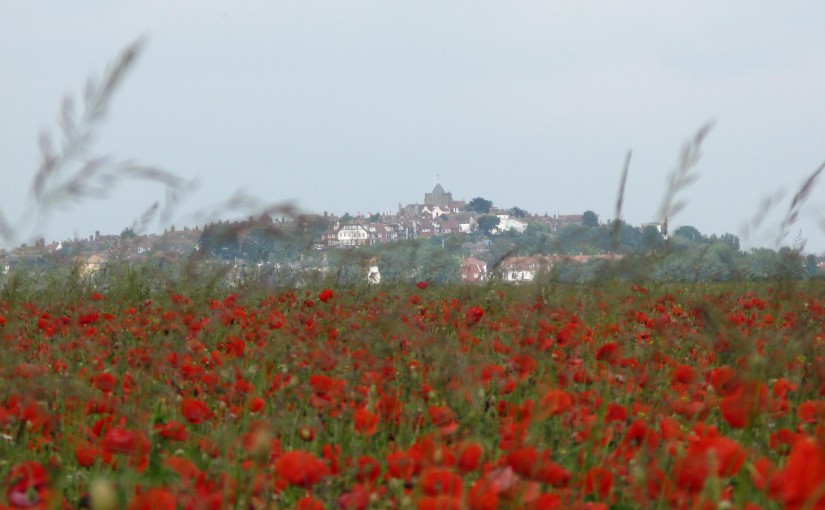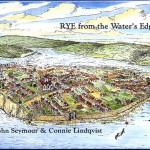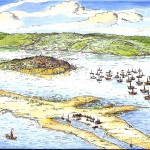The Field of Battle
We have all heard of Flanders Fields, where poppies bloomed across the battlefields and were said by soldiers of that terrible war to represent the blood of the thousands that fell there, but what of the poppy fields of Rye?
Those driving on the Udimore road recently cannot have failed to notice the vast splash of crimson in the fields between Winchelsea and Rye. These poppies have appeared from time to time over the years but it is not often that there has been such a brilliant display as has occurred this year.
Could there have been a battle on that spot, as there was at Flanders? The answer is yes!
On a fine clear day in August 1350 the Cinque Ports Fleet lay at anchor on that very spot, which was then under the sea. Warning came that a Spanish Fleet was moving up the Channel. Fears that raiding would take place on these shores had prompted the King to act. His fleet was ordered to stand by at Winchelsea, and it was there he joined it, leaving the Queen at Lord Echyingham’s house in Udimore.
The Spanish Fleet had left Sluys in Belgium and was heading up the Kent coast. Once round the headland and into Rye Bay it made a bee line for the Ancient Towns. The Cinque Ports Fleet sailed to meet it head on.
Brave Men Set Out To Fight The Spaniards
What a brave sight those fine vessels must have made as they passed in single file out of the mouth of the large sheltered lagoon that then served Rye and Winchelsea, into the bay. Large crowds on the Cadborough Cliffs, including the Queen and her party, watched them leave. Edward III was King of England, and it was he that led his brave ships into battle.
The Spaniards Had The Advantage
The archers and stone-casters in the Spanish fleet which was probably forty or more in number, had a great advantage over their English counterparts.
The small castle-like structures at the mast heads of the invaders were much higher than those on the Cinque Ports vessels. The reason for this was the respective sizes of the ships, the Spanish being deep-sea fishermen and built very large ships whereas the English fishing requirement were for shallow draft vessels, the men of war were of similar proportions.
The wind was favourable to the Spaniards, they could easily have avoided an engagement by bearing southwest and letting their greater speed move them out of reach of the English. Instead they came straight on, probably with the intentions of defeating the Cinque Ports Fleet and then going on to loot the two Ancient Towns.
In a head-on collision with one of the invaders, the King’s ship was badly damaged, with his men madly bailing out the water which poured in through great splits in the side of the vessel, the King was forced to break off his engagement. In fact several Cinque Ports ships had setbacks at this stage of the battle and were forced back into the lagoon where the fighting continued, right under the noses of the Queen and her entourage. By this time the King’s ship had managed to break away from the Spaniard and once free from his foe, the leaks were stopped and the ship was able to rejoin the fray.
The King Was In Trouble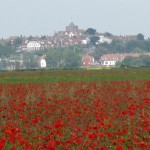
Small battles were taking place all over Rye Bay by this time, but due mainly to the bravery of the English fighting man, the tide of battle slowly swung in favour of the Cinque Ports Fleet. The King, however, was in terrible trouble, after ramming another and even larger Spanish vessel, his ship burst at the seams and was sinking fast. With bravery, born of fear and desperation, the King’s Knights gathered about him and with one mighty assault, they boarded the Spaniard and threw their enemies into the sea.They were only just in time, as they secured the Spanish vessel their own gallant ship sunk below the waves, ending her life on the bed of Rye Bay.
Fearless Acts of Heroism
Fearless acts of heroism were performed by the English over the entire field of battle and by dusk victory was in their grasp. One ship, however, was still locked in battle with the largest of the Spanish ships, unable to break off the engagement because her bow was buried deep into the side of her adversary and being prevented, by weight of numbers, to board the Spaniard. The ship of Rye was carried far out to sea by the mighty sails of the larger vessel. All seemed lost for these men, and as none of the other Cinque Ports ships had seen the incident, they were unable to go to their aid.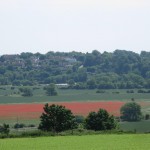
The view from Cadborough Cliff. A sea of red poppies on the spot the Cinque Ports Fleet was moored in 1350 when the Spanish Raiding Fleet came into Rye Bay set on plundering Winchelsea and Rye. A mighty Battle ensued within the sight of the Queen and her party which they may well have viewed from about the same spot as this picture was taken. After a long encounter, which was touch and go for a period, the Cinque Ports crews and fighting men were victorious. In all twenty-four Spanish ships were captured, the remainder were sunk or fled. There was heavy loss of life on both sides. Looking from Cadborough today and viewing the mass of red poppies one wonders if the Flanders poppies are replicated here.
Hanequin Saved The Day
The day was saved by one, Hanequin, who, taking his sword between his teeth, leapt onto the Spanish man of war, fought his way single handed to the foot of the mighty mast and slashed the hawser that held up the sail. With its sails falling over its decks, the Spanish ship came to a standstill. The men of Rye took advantage of the situation and swarmed to the attack. The ship was cleared of Spaniards and the triumphant men of Rye returned to harbour with their prize. In all about twenty four Spanish ships were captured, the remainder either sank or fled.
Hundreds Perished
Hundreds of men perished that day, many right over the spot where poppies grow today. Do the crimson poppies rise in their thousands to pay tribute to the fallen in that far off engagement that was another small part in this Islands history? Who can really say? But had you asked any of those brave survivors from the more recent War of 1914-18 who witnessed the blooming of the poppies over the hideous killing fields of Flanders they would have told you that what they witnessed was no more than a miracle, to them the sea of red that grew before their eyes was no less than the blood of their fallen comrades. The poppy became the emblem of remembrance and we still proudly wear them on the eleventh hour of the eleventh day of the eleventh month.
Perhaps now, when the poppies grow in the fields under Cadborough Cliffs, we will spare a thought for those brave men of the Cinque Ports Fleet, who were killed or drowned defending their homeland in that desperate Battle of Rye Bay 750 years ago.
Rye’s Own July 2008
All articles, photographs and drawings on this web site are World Copyright Protected. No reproduction for publication without prior arrangement
